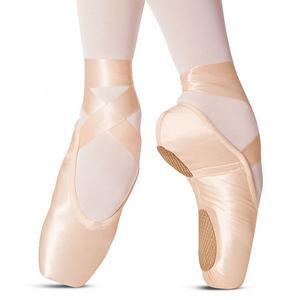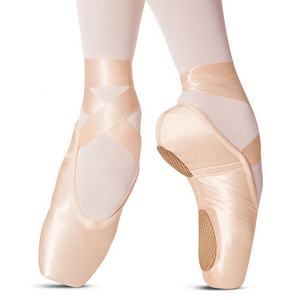
What are Pointe Shoes?
A ballerina is known for her ability to stand on the tips of her toes in shiny, satin shoes. Pointe shoes are special ballet shoes that support the foot and allow a dancer to achieve this feat. Because all of the dancer’s weight is distributed over a very small platform at the tip of the shoe, a lot of force is put on the dancer’s feet.
Pointe shoes developed from the desire for dancers to appear weightless and sylph-like and have evolved to enable dancers to dance en pointe (on the tips of their toes) for extended periods of time. They are normally worn by female dancers, though male dancers may wear them for unorthodox roles such as the ugly stepsisters in Cinderella, Bottom in A Midsummer Night’s Dream, or men performing as women in dance companies such as Les Ballets Trockaderoand Grandiva.
They are manufactured in a variety of colours,red, black, yellow and various shades of Pink, however the most common are shades of light pink.
Women began to dance ballet in 1681, twenty years after King Louis XIV of France ordered the founding of the Académie Royale de Danse. At that time, the standard women’s ballet shoe had heels. Mid-18th century dancer Marie Camargo of the Paris Opéra Ballet was the first to wear a non-heeled shoe, enabling her to perform leaps that would have been difficult, if not impossible, in the more conventional shoes of the age. After the French Revolution, heels were completely eliminated from standard ballet shoes. These flat-bottomed predecessors of the modern pointe shoe were secured to the feet by ribbons and incorporated pleats under the toes to enable dancers to leap, execute turns, and fully extend their feet.
The first dancers to rise up on their toes did so with the help of an invention by Charles Didelot in 1795. His “flying machine” lifted dancers upward, allowing them to stand on their toes before leaving the ground. This lightness and ethereal quality was well received by audiences and, as a result,choreographers began to look for ways to incorporate more pointework into their pieces.
As dance progressed into the 19th century, the emphasis on technical skill increased, as did the desire to dance en pointe without the aid of wires. When Marie Taglioni first danced La Sylphide en pointe, her shoes were nothing more than modified satin slippers; the soles were made of leather and the sides and toes were darned to help the shoes hold their shapes. Because the shoes of this period offered no support, dancers would pad their toes for comfort and rely on the strength of their feet and ankles for support.
Every dancer has unique feet, with variations that include toe length and shape, arch flexibility, and mechanical strength. Consequently, most pointe shoe manufacturers produce more than one model of shoe, with each model offering a different fit, as well as custom fitted shoes. Regardless of the manufacturer or model, however, all pointe shoes share two important structural features that enable dancers to dance on the tips of their toes:
- A box within the front end of the shoe that encases and supports the dancer’s toes.
- A shank, which is a piece of rigid material that serves to stiffen the sole so as to provide support for the arch of the en pointe foot.
The lifetime of a pointe shoe depends on many factors, including:
- Usage. More aggressive dance styles and more frequent, longer durations of use will hasten wear.
- Dance technique. Improper technique subjects shoes to unusual stresses that may lead to premature failure.
- Fit. Well fitting pointe shoes encourage proper technique, which in turn leads to longer shoe life.
- Weight. Greater dancer weight exerts proportionally greater stresses to the shoes, leading to faster wear.
- Construction. Varying qualities and types of construction will yield different life expectancies.
- Shank material. The stiffness and integrity of various shank materials will degrade at varying rates.
- Breaking-in. The breaking-in process simulates accelerated wear, and thus may shorten the life of a shoe.
- Performance surface. Rough surfaces cause rapid wear of the exterior fabric, in contrast to smooth surfaces such as Marley floors, which minimize the rate of fabric wear.



